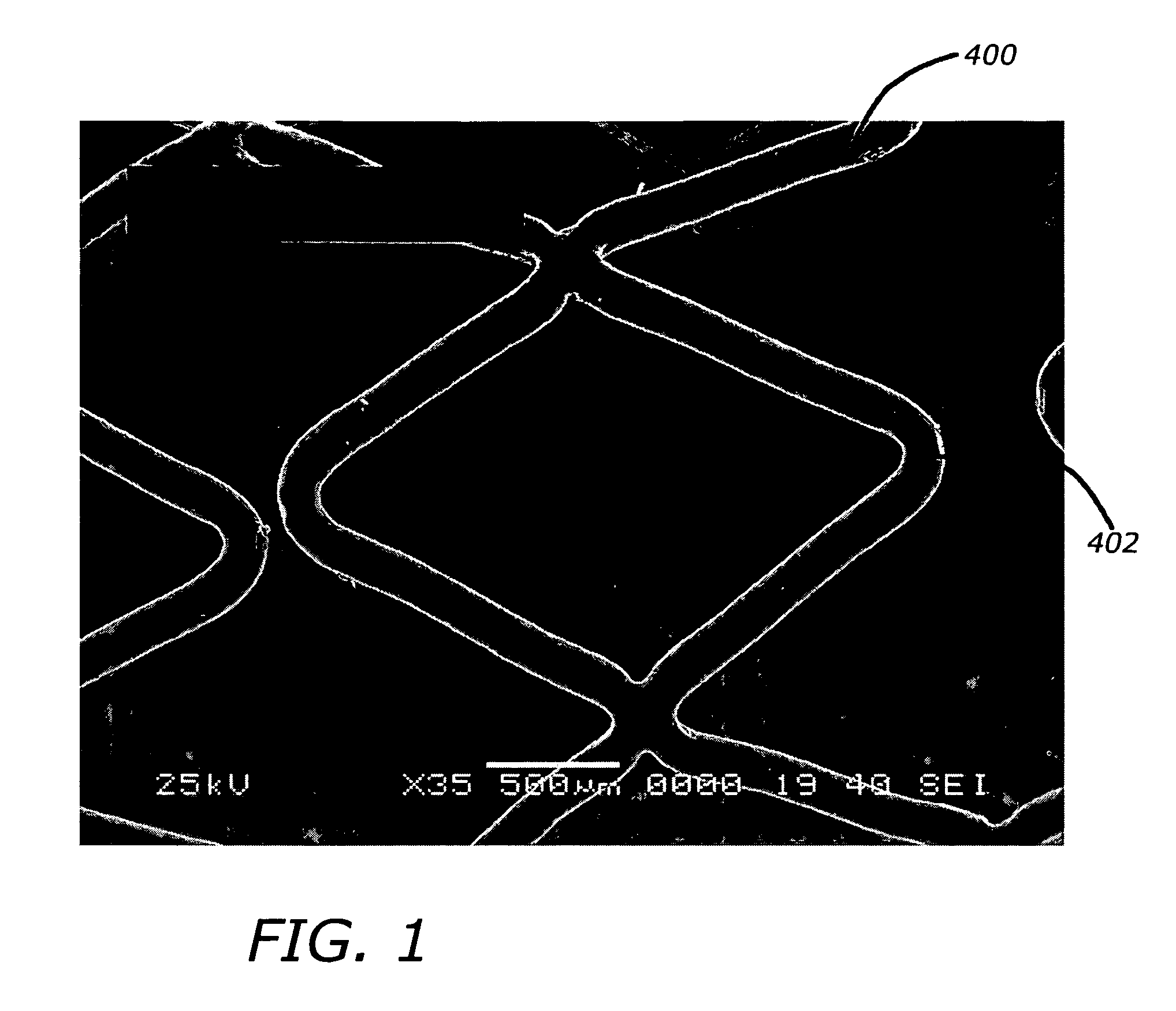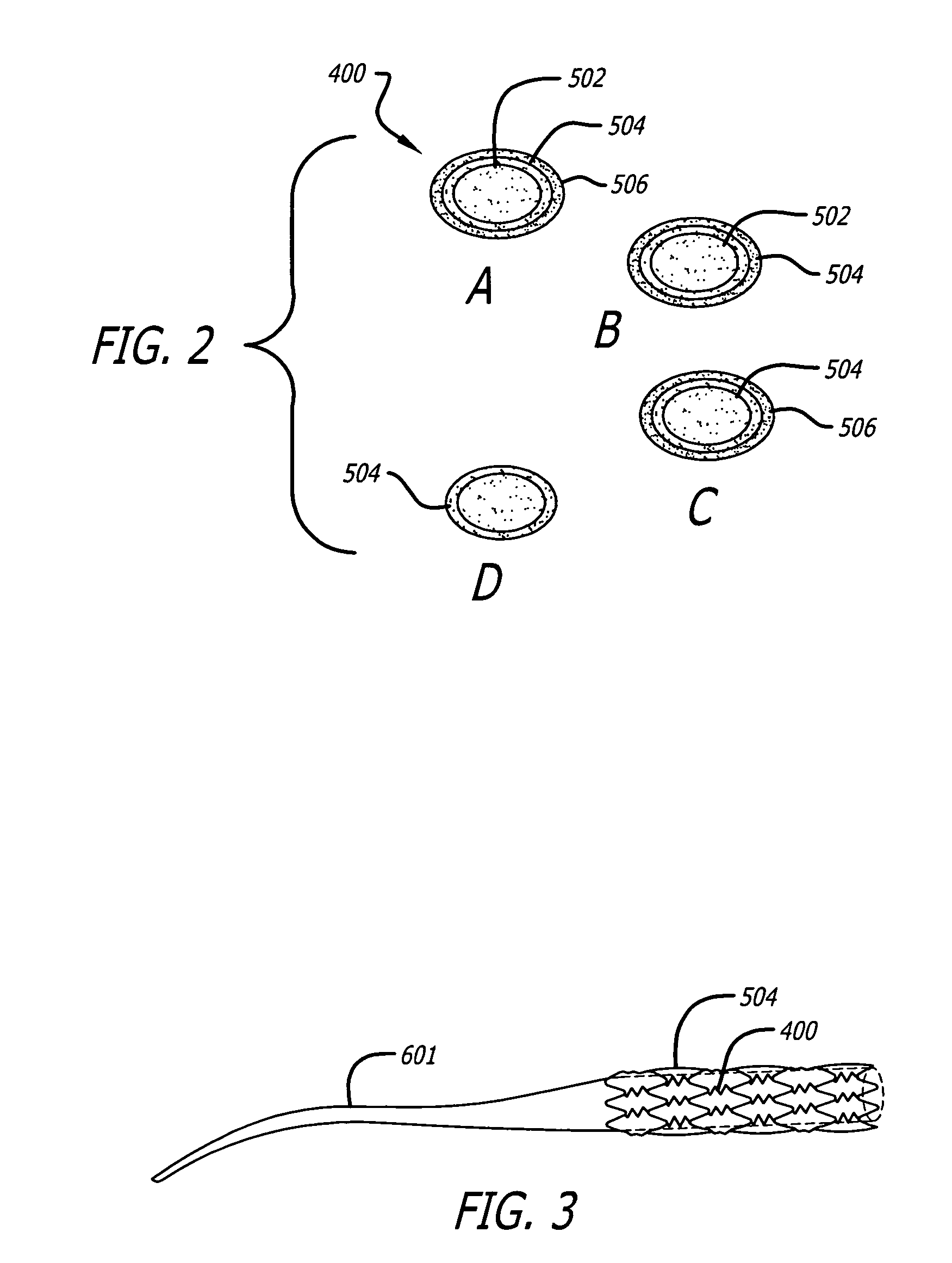Angiotensin-(1-7) eluting polymer-coated medical device to reduce restenosis and improve endothelial cell function
an angiotensin-eluting polymer-coated, medical device technology, applied in the direction of prosthesis, blood vessels, peptide/protein ingredients, etc., can solve the exact cellular functions that must be inhibited, the duration of inhibition needed to achieve prolonged vascular patency (greater than six months) is not known, and achieves the effect of improving the function of the vascular endothelial cell
- Summary
- Abstract
- Description
- Claims
- Application Information
AI Technical Summary
Benefits of technology
Problems solved by technology
Method used
Image
Examples
example 1
Angiotensin-(1-7) Pump Study in Rat Aorta Model
[0067]The effects of Ang-(1-7) on restenosis were studied in rats with uncoated stents implanted in the abdominal aorta with Ang-(1-7) infused by implantable micro pump. Twelve rats per group were implanted with stents and micropumps containing one of three infusion regimens for three weeks. Control rats received saline infusions and the Ang-(1-7) groups received infusion of Ang-(1-7) at 10 μg / kg / hr or 24 μg / kg / hr.
[0068]
TABLE 1Results of Rat Aorta Pump StudyMean InjuryMedia AreaNeointimalPercentageNeointimalGroupScore(mm2)area (mm2)Stenosis (%)Thickness (mm)Control0.93 ± 0.070.47 ± 0.040.70 ± 0.07 13.9 ± 1.3 141 ± 11Ang-(1–7)1.11 ± 0.160.40 ± 0.050.51 ± 0.05*10.4 ± 1.0**111 ± 824 μg / kg / hr*p = 0.035;**p = 0.016 vs. control
[0069]Rats that received a lower infusion level of Ang-(1-7), 10 μg / kg / hr, did not show any significant difference compared to the control group in any of the parameters measured. The rats receiving 24 μg / kg / hr, howeve...
example 2
Design of Angiotensin-(1-7) Eluting Stent
[0070]The design of an Ang-(1-7) eluting stent comprised a first layer of an amphiphilic copolymer containing 10–20% by weight of Ang-(1-7) and optionally a second coating (tocoat). The optional topcoat provides an additional barrier capable of providing sustained release of Ang-(1-7).
[0071]An amphiphilic PEG methacrylate-cyclohexyl methacrylate copolymer (designated C45, see co-pending U.S. patent application Ser. No. 10 / 970,171) was dissolved in methanol (MeOH) at room temperature overnight while shaking to a concentration of approximately 0.5% (wt / vol). Ang-(1-7) was added to the dissolved copolymer so that concentrations of 10% to 20% by weight of Ang(1-7) relative to C45 were achieved.
[0072]The C45 / Ang-(1-7) solution was sprayed on 8 mm Medtronic Driver stents using standard spraying equipment in which the copolymer solution was vaporized ultrasonically. Coating weights were approximately 150 μg to 600 μg per stent. The optional topcoat ...
example 3
Release of Angiotensin-(1-7) from C45 Coated 8 mm Stents in Vitro
[0073]For an in vivo study of Ang-(1-7) release from coated stents implanted in rat aortas, a series of 8 mm stents was prepared. For the release study, 8 mm stents were coated with C45 loaded with 20% by weight Ang-(1-7) applied as a 0.5% (wt. / vol.) solution in MeOH with a coating weight of 150 μg. The topcoat was C45 (60 μg to 300 μg, applied from chloroform). The results of the in vitro release study are presented in FIG. 4. The release tests were performed in triplicate in phosphate-buffered saline (PBS) (pH 7.4) at 37° C. for periods up to 28 days. The stents were incubated in 750 μL of PBS containing sodium azide and at specific times the stents were removed from the PBS and the releasing media was analyzed for Ang-(1-7) using standard fluorescence techniques.
[0074]The stents with no topcoat demonstrated a 70% burst and a sustained release for a few weeks. The release rate at day 21 was approximately 0.4 μg / day (...
PUM
| Property | Measurement | Unit |
|---|---|---|
| weights | aaaaa | aaaaa |
| weight | aaaaa | aaaaa |
| pH | aaaaa | aaaaa |
Abstract
Description
Claims
Application Information
 Login to View More
Login to View More - R&D
- Intellectual Property
- Life Sciences
- Materials
- Tech Scout
- Unparalleled Data Quality
- Higher Quality Content
- 60% Fewer Hallucinations
Browse by: Latest US Patents, China's latest patents, Technical Efficacy Thesaurus, Application Domain, Technology Topic, Popular Technical Reports.
© 2025 PatSnap. All rights reserved.Legal|Privacy policy|Modern Slavery Act Transparency Statement|Sitemap|About US| Contact US: help@patsnap.com



